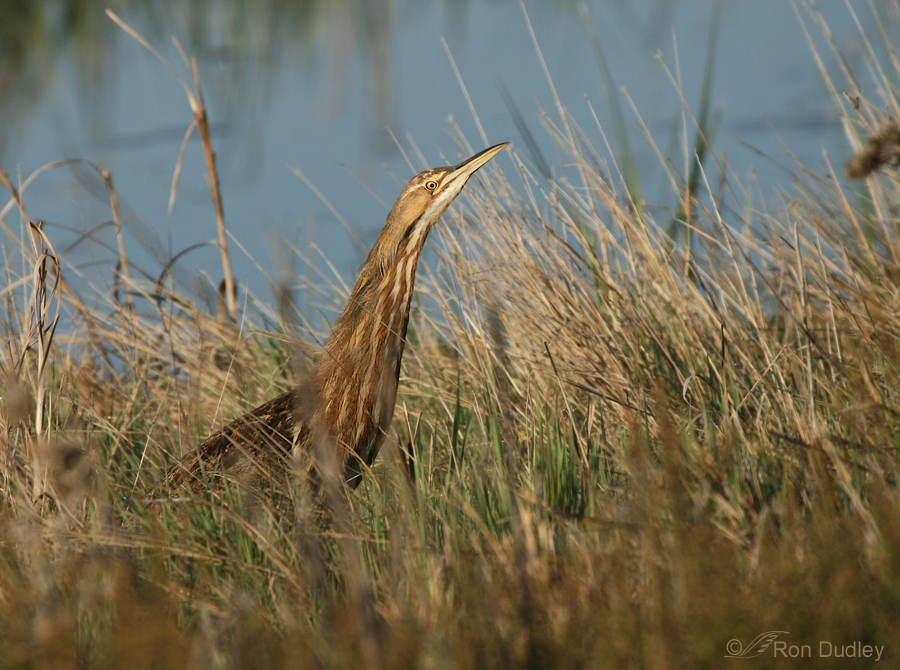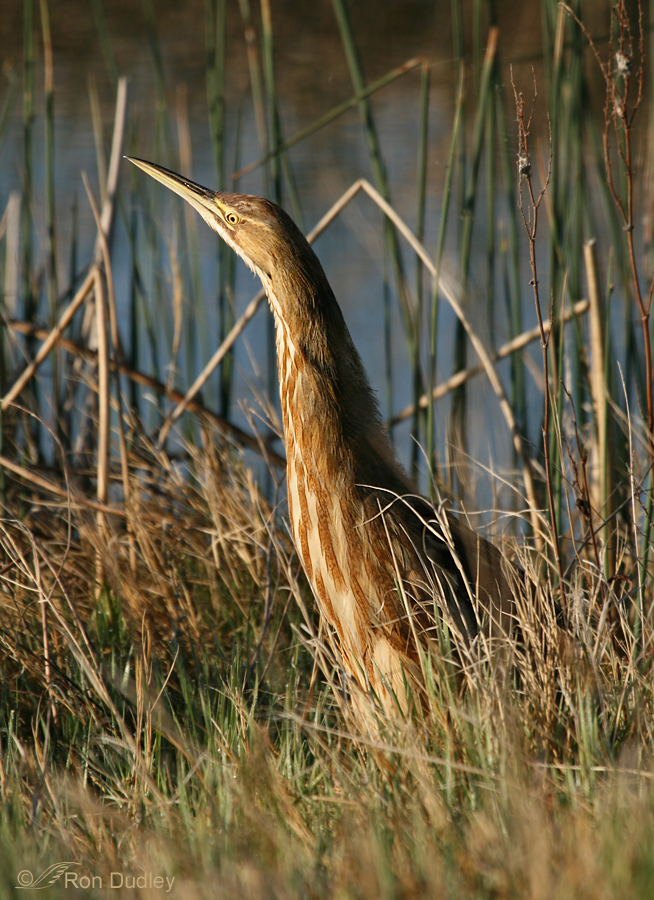The American Bittern may be the most elusive avian subject I’ve ever photographed. They’re solitary, cryptically colored and their preferred habitat is wetlands with tall, emergent vegetation. And they’re extremely secretive by nature. So much so that very little is known about their biology, which is too bad because perhaps if we understood them better we could more effectively manage their seriously declining populations.
They’re an interesting species for a variety of reasons. For example, they have a resounding, low-frequency call that enables them to communicate with each other through the visually and acoustically restricting tall, thick vegetation that they prefer (low sound frequencies penetrate these barriers best). Their unique call is the reason for one of their common names, “thunder-pumper”.
When alarmed they typically go into what is referred to as the “bittern stance” where they stretch their body vertically with their bill pointed upward, press their feathers flat against the body and then sway with the breeze just like the surrounding vegetation. This behavior, when combined with their cryptic coloration, can make them virtually impossible to spot. Pretty neat.
1/1000, f/7.1, ISO 200, 100-400 @ 400mm, natural light
In 7 years of photographing birds, often in wetland habitats preferred by bitterns, this was the best opportunity I’ve ever had with the species. I found this bittern at Bear River Migratory Bird Refuge. As is typical it was fairly deeply buried in vegetation but at least it was close and I liked the light. With me so close (in my pickup) it assumed the “bill pointed up” pose.
1/500, f/7.1, ISO 200, 100-400 @ 400mm, natural light
Then it turned around and walked, ever so slowly, back to the shore of the canal and disappeared in the reeds and grasses.
Ron
PS – My blog has been down all morning, at least in part due to the incompetency of Network Solutions (yes, I’m extremely frustrated). I apologize for the inconvenience.




Ron,
I like how the Bittern prefers to freeze and not flush. This gave me a very cooperative model at Whitewater Draw a few months ago. I was able to follow the Bittern on its rounds for an entire day and some of the next day and watch it catch a frog. I posted some of the pics on my blog: http://www.vermphoto.com/blog/2013/2/verm-gets-em-bitterned. The best avian model I’ve ever run into.
Keep up the great shooting. I really appreciate how you share your stories of bird behavior.
Cheers,
Verm
Fascinating birds, and yes almost impossible to see can remember the first one with my grandparents.
Great images as usual, and I agree with you about frustration.
Been having computer problems now for two weeks, the computer has been to the DR’s two separate times with no one able to fix the recurring mouse icon fluttering and character burst. Shut it down, restart after 5 or 10 minutes and it is OK again for 1/2 hour, hour or so, than it happens again. Very frustrating.
At any rate, I know how difficult it is to see, let alone photograph Bitterns. Bents Life Histories, yes, I know it is old, gives an interesting read!
And let me guess, people moving into their habitat are a likely cause of their declining numbers. Research, research, research – and then corrective action. Please.
I can well understand how these birds can ‘disappear’ without moving. A change in the angle of light hitting them could make them well nigh invisible.
I felt very lucky to have seen a bittern at Bear River Migratory Bird Refuge a few years ago. Just happened to look at the right spot at the right time. Such a cool bird.
Hi Ron, nice series. I recently got a chance to photograph an American Bittern, a first for me. One trait I noticed was when they want to check you out, they stretch vertically as you said presumably to blend in with the camo. However what about their vision? When I shot the image below, I thought of you and the biology of the pose. Does this head position give them binocular vision and see predators better? Curious…….
Chris
http://www.flickr.com/photos/47963768@N08/8590838332/in/photostream/
That’s a classic look at the eyes of a bittern, Steve. I’d guess they must have binocular vision when looking that direction with their head in that position – both eyes seem to be focused on you.
Ron:
I agree … pretty neat. I once spotted one, took some photos, looked away and was not able to relocate the bird which had not moved for several minutes. Nice light, sharp images.
Dave
Wow, Dave – that’s a perfect example of how effective their camo is.
I’ve only photographed one, ever, and that was five years ago. I’m not at all certain that it even IS a Bittern. Initially I identified it as a juvenile Green Heron…but that’s a questionable ID.
Perhaps you could give me the benefit of your expertise?
http://www.flickr.com/photos/vidterry/2843695506/
Thanks very much.
Terry – yes, it’s a juvie Green Heron. But to be perfectly honest I’m no expert on the species and have never photographed one so I asked a friend who knows these birds much better than I do. She confirmed your ID.
Ron, your photography never ceases to amaze me! I have never seen a bird like that. Thank you so much for being there every single for we “birdies”. I have to thank Donna Igo for sharing this with me!
Thanks very much, Karen. I’m delighted that you enjoy my images.
Wonderful photographs of a difficult bird to find! I love hearing that deep pumping call but it would be nice if I could see them once in awhile! The only photos I’ve managed were out of focus or of the bird’s rear as he slunk away.
Thank you for the interesting post!
Thanks, Wally. At least you get to hear them. I rarely do.
Dear Ron
No apologies needed, I assure you! You make my day, every day. I wake up to beautiful bird pictures that I would never otherwise see and enjoy. I can only imagine you driving along some country road in your truck with your noodle and finding the most beautiful scenery and bird habitat. I know nothing about the lens references you mention, as photography and cameras are somewhat a foreign language to me. I have a point and shoot Canon, so you see what I mean.
Thank you so much for all the time and dedication you give to your craft, and then share with us! From an old woman’s point of view, it’s awesome!
From “an old man’s point of view”, thank you for the very nice words, Diana.
As always fantastic pictures and very interesting information. This past winter there was at least one resident American Bittern at the South Padre Island Birding Center. I was fortunate to see it on several occasions. If the population is declining and there are at least some that frequent centers such as this, isn’t there any assistance that ornithologists like Cornell U. can provide to study and increase their numbers?
similar to what was done with out wonderful whooping cranes?
Thanks!
Charlotte
I don’t know, Charlotte. But Birds of North America Online (out of Cornell) seems to be almost pleading for more research to be done on this species.
Gorgeous photos!!
Thanks, Susan.